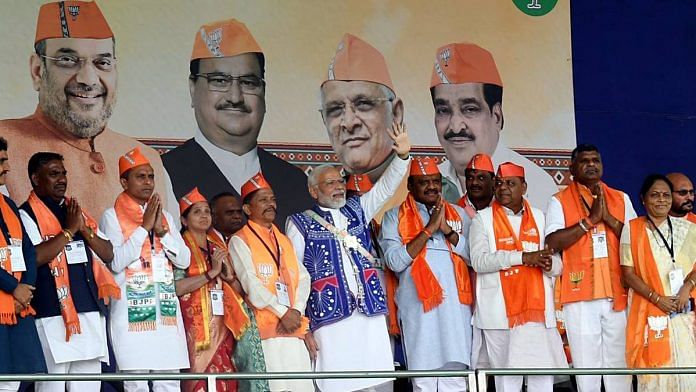New Delhi: For the first time in more than two decades of power in Gujarat, the Bharatiya Janata Party (BJP) seems to have breached the tribal belt as it won in 24 out of the total 27 reserved seats, in what has traditionally been the Congress bastion.
In contrast, the Congress, which traditionally dominated the tribal belt, won in 2 seats. Meanwhile, the Aam Aadmi Party (AAP), whose entry the BJP hoped would prove detrimental to the Congress, won one seat from Dediapada.
The development means that the BJP’s adivasi outreach — from nominating a tribal woman as the President to Prime Minister Narendra Modi’s visit to Mangarh Dham in neighbouring Rajasthan, a place revered by tribal people across the country — has paid off.
According to the 2011 Census, Gujarat’s tribal population stood at 89.17 lakh — about 15 per cent of its total population. There are sizeable tribal populations in Banaskantha, Ambaji, Dahod, Panchmahal, Chhota Udaipur, and Narmada districts.
Gujarat’s tribal belt — which stretches from Ambaji in the north to Umargam in Valsad district — was the only region where the BJP had struggled for dominance since 1995.
In 2017, the Congress won 15 seats while the BJP was restricted to 9. The Bharatiya Tribal Party (BTP) — which had been in an alliance with the Congress — wrested two seats while one seat went to an Independent candidate.
This time around, however, the BTP decided to contest the elections alone after a short-lived pre-poll alliance with the AAP, a relatively new player in Gujarat’s electoral space.
Earlier this year, largescale protests from the tribal belt led the central government to shelve the Par-Tapi-Narmada river-linking project — an issue that dominated discourse during the elections too, a Congress leader told ThePrint.
As for the Congress, this loss comes despite Rahul Gandhi, who had delinked himself from Gujarat and Himachal polls, took a break from his Bharat Jodo Yatra to campaign in tribal areas 10 days before the first phase of the assembly elections.
Rahul had addressed two rallies — one at tribal-dominated Mahuva in Gujarat’s Surat and the other at Rajkot. He had also kickstarted the Congress election campaign for Gujarat from Dahod, another tribal-dominated district, in May.
In the second phase of the elections, which included 13 ST seats, the highest voting percentage was reported from tribal-dominated constituencies — Sabarkantha reported the highest at 65.84 per cent, followed by Banaskantha 65.65 per cent and Kheda 62.65 per cent.
Also Read: ‘Moditva’, wooing tribals, scarce mention of CM: What BJP strategy in Gujarat yatra was all about
BJP’s tribal push
The battle between the Congress and the BJP in the tribal belt has been fierce.
From the appointment of Droupadi Murmu, a Santhal woman from Odisha who became India’s first tribal President earlier this year, to PM Modi’s visit to Mangarh Dham just ahead of the Gujarat polls, the BJP has been trying to reach out to the tribal community.
At his campaign rallies, Modi sought to corner the Congress for not supporting Murmu in the presidential poll held in July.
Apart from its promise to provide tap water to every household, the BJP also raised the issue of religious conversions, especially in Dahod.
During his visit to Mangarh Dham — also known as the ‘Adivasi Jallianwala Bagh’ — on 1 November, Modi paid tributes to 1,500 Bhils who were massacred by the British in the Mangarh Hills on 17 November 1913.
At the event, Modi had said that sacrifice by the tribals hadn’t got its rightful place in post-Independence history. He also spoke about Birsa Munda — a 19th century freedom fighter from the Munda tribe — saying that he ignited the flame of freedom among lakhs of tribal people.
“You will not find any patch of time — starting from the beginning of slavery centuries ago, till the 20th century — when the flame of azadi (freedom) wasn’t kept ablaze by the tribal community,” he said.
The BJP leaders hoped that the visit would help it clinch tribal votes in Gujarat.
Gandhi’s ‘Adivasi Vs Vanvasi’ pitch falls flat
As for the Congress, it had focused on securing adivasi votes since the beginning of its election campaign, even releasing an ‘adivasi patra’ — a document listing the tribal issues that the party promised to focus on throughout its campaign and the policies that it claimed to implement if it came to power.
At his Mahuva rally, Rahul attacked the BJP for referring to the tribals in the state as ‘vanvasi’ (forest dwellers) as opposed to ‘adivasi’ — a nomenclature that the Congress uses.
Rahul said that his party stood for adivasi rights and treated them as the “first owners (maaliks) of the country” while the BJP “snatched their land to give them to industrialists”.
He also credited his grandmother, late prime minister Indira Gandhi, for teaching him about the country’s “deep relationship with adivasis”.
“The people of BJP don’t call you, adivasi. What do they call you? Vanvasi. They don’t tell you that you are the first owners of Hindustan. They tell you that you live in the jungles, meaning they don’t wish that you live in cities, that your children become engineers, doctors, fly planes, speak in English,” Rahul had told the rally.
The pitch, however, did not work, reducing the party to three seats in the tribal belt, so far.
Additionally, an exodus of tribal leaders from the Congress to the BJP — such as Ashwin Kotwal, a three-time MLA from Khedbrahma in Sabarkantha district — also seems to have hurt the opposition party.
(Edited by Uttara Ramaswamy)
Also Read: Jolted by Congress outreach to MP tribals, BJP doubles down on its own efforts ahead of polls






